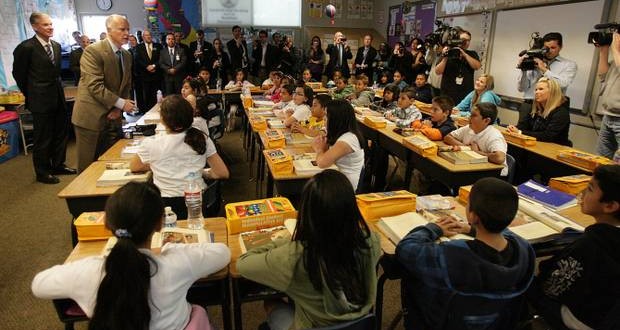
Terry Pierson/The Press-Enterprise
Gov. Jerry Brown speaks in Susan Cummins’ 4th grade class at Arlanza Elementary School in Riverside in 2011.
SACRAMENTO — A compromise school-funding formula at the heart of this week’s state budget deal includes more money for suburban and wealthier districts, addressing complaints that an earlier Brown administration plan was unfair.
There will still be extra money targeted at English learners, students receiving free meals, and foster children. But it will comprise a smaller piece of the funding pie than what Brown wanted when he warned his plan’s critics in April that they were in for “the battle of their lives.”
“It’s an improvement, definitely, but we’re still waiting to get all of the details,” said Lori Ordway-Peck, assistant superintendent for business support services at Temecula Valley Unified School District, where officials had raised concerns about the Local Control Funding Formula the governor unveiled in January.
Supporters say the compromise plan will increase funding for schools by about $23 billion over eight years, making up for past cuts while simplifying the state’s school-funding system and helping disadvantaged students close the achievement gap.
Under this week’s agreement, more money will go into base grants for all pupils. The Temecula district, for example, would get a per-pupil increase of more than $3,000, to about $9,400, by 2020-21, according to Department of Finance estimates.
Brown’s formula would have phased in a year earlier, which prevents direct comparisons to the compromise plan.
In seven years, though, Temecula Valley’s per-pupil funding would have increased by only $2,100, based on February estimates by the finance department.
Stacy Coleman, assistant superintendent for business services for the Murrieta Valley Unified School District, said he’s also waiting for more specifics on the proposal.
Murrieta Valley, where about a third of the students are disadvantaged, would receive about $3,000 more in per-pupil funding, to $9,500, by 2020-21. The governor’s earlier plan estimated that the district would receive $9,000 by 2019-20.
Additional base funding is good, Coleman said. He cautioned, though, that the additions could come at the expense of cuts elsewhere. The final result may not be much gain over what the district had expected under existing law, he said.
Disadvantaged districts
Inland districts with large percentages of disadvantaged students, such as Fontana Unified, San Bernardino City Unified and Val Verde Unified, would get almost twice as much in per-pupil funding by the time this week’s compromise takes full effect.
Dale Marsden, superintendent of San Bernardino City Unified, said the compromise formula is just as good for his district as the governor’s January proposal.
“There are no losers,” Marsden said. “Everybody’s base has gone up. But we still have a long way to go.”
This week’s agreement includes “supplemental” payments to districts. Those will be equal to 20 percent of the base grant for every disadvantaged student. Brown had wanted 35 percent.
And districts will qualify for extra “concentration” funding when 55 percent of their students are disadvantaged, up from a 50-percent threshold in the governor’s approach.
Some districts also will get an “economic recovery payment” to restore them to 2007-08 revenue levels.
“What we have here is a final agreement that has the same essential architecture as the governor’s proposal, with some changes,” Department of Finance spokesman H.D. Palmer said Wednesday.
Assemblywoman Cheryl Brown, whose district includes the Fontana and San Bernardino districts, was an early backer of the governor’s plan.
“I’m here with members who are from suburbia,” Brown, D-San Bernardino, said. “They were really concerned they were being short-changed. The way this has turned out, no one is short-changed. Those who need more, will get more.”
Governor’s plan
Some Inland school officials, though, said the governor’s plan would have been better for districts with mid-range percentages of disadvantaged students.
Mike Fine, Riverside Unified’s deputy superintendent for business services, said the district will receive about $1,000 less per pupil in supplemental money under the compromise. About two-thirds of the district’s 40,000 pupils are disadvantaged.
Brown’s acceptance of this week’s deal, Fine said, “was a little shocking to me. I think it goes against some of the governor’s principles.”
The approach to distribute the concentration money, Fine added, fails to recognize that some districts — such as Riverside Unified and Corona-Norco Unified — are short of the 55 percent threshold but have schools that meet it. Senate Democrats had voiced similar complaints about the governor’s plan but signed on to the compromise.
Assembly President Pro Tem Darrell Steinberg, D-Sacramento, praised the agreement. It gets more money to all districts, he said, while maintaining the essence of the governor’s “progressive proposal.”
BY JIM MILLER AND
MICHELLE KLAMPESTAFF WRITERS
June 12, 2013
 Westside Story Newspaper – Online The News of The Empire – Sharing the Quest for Excellence
Westside Story Newspaper – Online The News of The Empire – Sharing the Quest for Excellence




